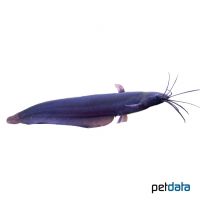Stinging Catfish (Heteropneustes fossilis)
| Stinging Catfish Heteropneustes fossilis | |
|---|---|
| Name | Stinging Catfish |
| Name Lat. | Heteropneustes fossilis |
| Family | Airsac Catfishes |
| Family lat. | Heteropneustidae |
| Order | Catfishes |
| Order lat. | Siluriformes |
| Origin | Asia |
| Habitat | Streams, swamps, ponds |
| Diet | Omnivore |
| pH | 6.0-8.0 |
| Behavior | Nocturnal, predatory |
| Keeping | Individual, group |
| Care Level | Difficult |
| Reproduction | Substrate spawner |
| Breeding | Difficult |
| Life Span | 5-8 years |
| Protection | No |
| Metric Units | |
| Size | 25-30 cm |
| Temperature | 20-30 °C |
| Hardness | 5-30 °dH |
| Aquarium | 250 l |
| US Units | |
| Size | 10"-12" |
| Temperature | 68-86 °F |
| Hardness | 89-534 ppm |
| Aquarium | 65 gal |
Distribution and habitat
The nocturnal spoked catfish are widespread from Pakistan through India and Sri Lanka to Myanmar. They are mainly found in ponds, pools, swamps and marshes, often with a low oxygen water, as well as in sluggish flowing, muddy rivers.
Maintenance
The aquarium should have dense planting, with plenty of hiding places, such as caves (catfish tubes, perforated rock) and roots, and provide adequate swimming space. A dark muddy soft substrate and subdued light (floating plants) is ideal
No ammonia, ammonium and nitrite should be detectable, the nitrate value should not exceed 100 mg/l. To ensure the water quality and oxygen content, a filter and heater adapted to the aquarium size is required, as well as lighting for the species-appropriate day-night rhythm of the animals.
Diet
They are uncomplicated, greedy eaters. The food supply consists of live, frozen and dry food. For a balanced diet once a day with a high-quality dry food for catfish (granules, tablets, pellets) and Artemia. Feed mysis, tubifex or mosquito larvae (live or frozen) and according to their size with earthworms, mealworm larvae, shrimps, mussel meat and fish pieces. Feeding should be done in the evening hours.
Only as much should be fed as is eaten in a few minutes. A regular and varied diet promotes health and prevents deficiency symptoms.
Behaviour and compatibility
It is recommended to keep these sociable fish in a group of 2-5 animals. They are very peaceful and can be socialized well with similar sized fish, such as Asian barbs or cichlids. Fish that are too small are considered prey.
Basically, only mutually compatible fish species with similar demands on water conditions and water temperature should be socialized.
Sex dimorphism
No external distinguishing characteristics are known. Adult females appear rounder than the males.
Reproduction and breeding
Occasionally, breeding in the aquarium has been successful. The eggs, often several thousand, are usually spawned in a previously fanned out pit and guarded by the male. After about 24 hours the fry hatch and swim freely after 5 days. They are guarded for a few more weeks before brood care ends. The young fish grow very fast and are already sexually mature after one year
Fry must be fed several times a day with special rearing food (Artemia nauplii). In community tanks breeding is hardly possible, because the fry are easy prey.
Important
Great care should be taken when handling the spoked catfish, as their pectoral fin rays are connected to venom glands. Injuries are very painful and should be treated by a doctor if necessary. When trapping, use the finest mesh nets possible to prevent the hard rays of the pectoral fins from becoming entangled. They have an additional respiratory organ (gill tubes) with which they can breathe atmospheric air and thus survive in oxygen-poor waters. The aquarium should be very well covered to prevent escape
The well-being of the fish should be checked regularly. Temperature should be checked daily, pH, hardness and nitrate levels at least every 14 days. Regular partial water changes are recommended, even if the contaminant level has not yet reached the upper limit. Sudden changes in water quality should be avoided. Newly introduced fish must be accustomed slowly to the water in the aquarium.
Further literature can be found in your pet store.
References
Text: Werner Winter; Image: petdata
Source: BMELV (1998): Tierschutzgutachten - Haltung von Zierfischen (Süßwasser); BAENSCH & RIEHL(2006): Aquarien Atlas Bd. 2, Mergus Verlag; ENGELMANN (2005): Zootierhaltung - Tiere in menschlicher Obhut: Fische; Harri Deutsch Verlag
- Gemäß § 21 Abs. 5 Tierschutzgesetz idgF
